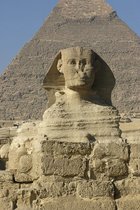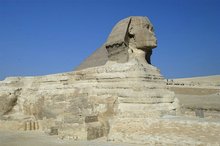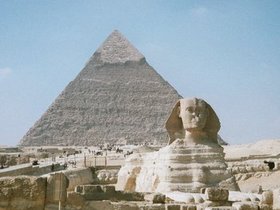Great Sphinx of Giza
|
|
The Great Sphinx of Giza is a large half-human Sphinx statue in Egypt. Believed by Egyptologists to have been built by ancient Egyptians about 4,500 years ago, on the Giza Plateau on the west bank of the Nile River, it is the largest single-stone statue on Earth.
The Great Sphinx faces due east, with a small temple between its paws.
| Contents |
Description
The Great Sphinx is a half-human statue made from limestone, with the face of a man and the body of a lion. It is 57 metres (260 feet) long, 6 m (20 ft) wide, and has a height of 20 m (65 ft), making it the largest single-stone statue in the world. It is located on the west bank of the Nile River within the confines of the Giza pyramid field, so that when approching from Memphis, the Sphinx is seen in profile in front of the Great Pyramid of Khufu.
After the necropolis was abandoned, the Sphinx became buried to its shoulders in sand. The first attempt to dig it out dates back to 1400 BC, when the young Tutmosis IV, falling asleep beneath the giant head, dreamt that he was promised the crown if he would only dig the Sphinx out. The young prince immediately formed an excavation party which, after much effort, managed to dig the front paws out. To commemorate this effort, Tutmosis IV had a granite stela known as the Dream Stela placed between the paws. It was only in 1817 that the first modern dig, supervised by Captain Caviglia, uncovered the Sphinx' chest completely. The entirety of the Sphinx was finally dug out in 1925, to the great pleasure of its numerous visitors.
The body of the Sphinx was carved out of solid bedrock whose removed stones some weighing upwards of 200 tonnes were used to construct the adjoining Sphinx Temple.
What name ancient Egyptians called the statue is unknown. Its Arabic name, Abu al-H?, translates as "Father of Terror". The Western name "Sphinx" was given to it based on the legendary Greek creature with the body of a lion and the head of a woman, but the Egyptian Sphinx has the head of a man, and therefore the name is not technically accurate.
Riddle of the Sphinx
The Great Sphinx is an international symbol of mystery and controversy. It is the world's largest statue and one of its oldest, yet basic facts about it are unknown, such as the real-life model for the face, when exactly it was built, and by whom it was built. These mysteries have collectively earned the title "Riddle of the Sphinx", a nod to its Greek namesake, although this phrase should not be confused with the original Greek legend.
Origins
The face of the Great Sphinx is generally thought to be a portrait of the Pharaoh Khafre (also known by the hellenised version of his name, Chephren), which would place its construction in the Fourth Dynasty (2723 BC–2563 BC). However, the idea that the face is that of Khafre is only based on the fact that his pyramid is behind the Sphinx when coming from modern Cairo; the political center of Ancient Egypt was Memphis, south of the Giza plataeu. When approching from Memphis the Sphinx is seen in profile in front of the Great Pyramid of Khufu, who shares more physical similarities with it and was built by his son. When compared with statues of Khafre at the Cairo Museum, it is evident that the face on the Sphinx is different from the face on the statues.
Other theories exist. In 2004, French Egyptologist Vassil Dobrev announced the results of a 20-year re-examination of historical records and uncovering of new evidence that suggest the Great Sphinx is the work of a forgotten Pharaoh named Djedefre, Khafre's half brother and a son of Khufu, the builder of the Great Pyramid. He suggests it was built by Djedefre in the image of his father Khufu, identifying him with the sun god Ra in order to restore respect for their dynasty.1
Other alternative theories re-date the Sphinx to pre-Old Kingdom – and, according to one hypothesis, to prehistoric – times.
Missing nose
The 1m wide nose on the face is missing. It has long been presumed that the nose had been broken off by a cannon ball fired by Napol鯮's soldiers. However, this is false, as sketches of the Sphinx by Frederick Lewis Norden made in 1737 and published in 1755 illustrate the Sphinx without a nose. An Arab historian from the 15th century attributes the vandalism to a Muslim fanatic in 1378. This explanation is corroborated by recent evidence which suggests that two bars, used as levers, were inserted at the base of the nose to remove it between the 10th and 15th centuries.
In addition to the lost nose, a ceremonial pharaonic beard is thought to have been attached, although this may have been added in later periods after the original construction. This relates to the later fashion of pharaohs, which was to wear a plaited beard of authority—a false beard (chin straps are actually visible on some statues), since Egyptian culture mandated that men be clean shaven. Pieces of this beard are present in the British Museum and the Cairo Museum.
Alternative dating theories
Water erosion
In recent years some geologists have suggested that, because of the pattern of water erosion evident on the bedrock walls of the area surrounding the Sphinx (the very bedrock from which the Sphinx's body was carved), it could have only been built no later than 6,000BC, the last time any significant volume of rain fell in Egypt. This new data, in conjuction with the corresponding astronomical alignments of the Sphinx and pyramids of the Giza plateau, suggests a date of 10,500 BC. This view of an earlier date of the Sphinx has not been accepted by mainstream Egyptology, which sees the erosion as made by wind and sand and not by water as the geologists propose.
Constellation of Leo
The lion shape may be in reference to the constellation of Leo. In 10,500 BC on the day of winter solstice the sun would have risen exactly between the paws of the sphinx. It was also the time when the equinox point was in the constellation of Leo. The Great Sphinx was possibly built to commemorate this event. One theory claims that the Sphinx was originally a lion statue whose head became damaged somehow. The head may have been replaced thousands of years later by the Egyptians, which could explain why the head is disproportionate with respect to the body.



